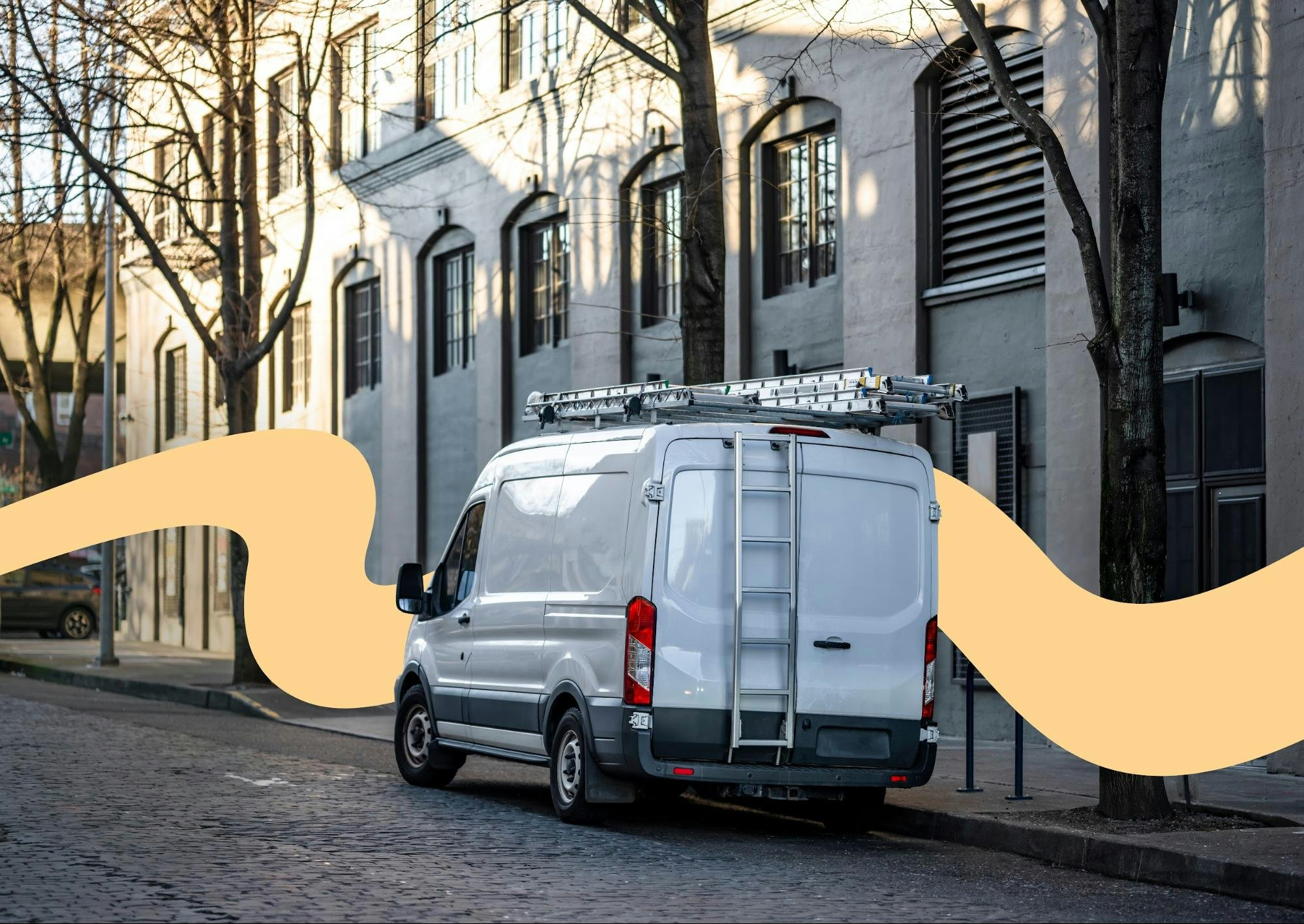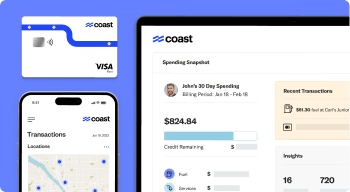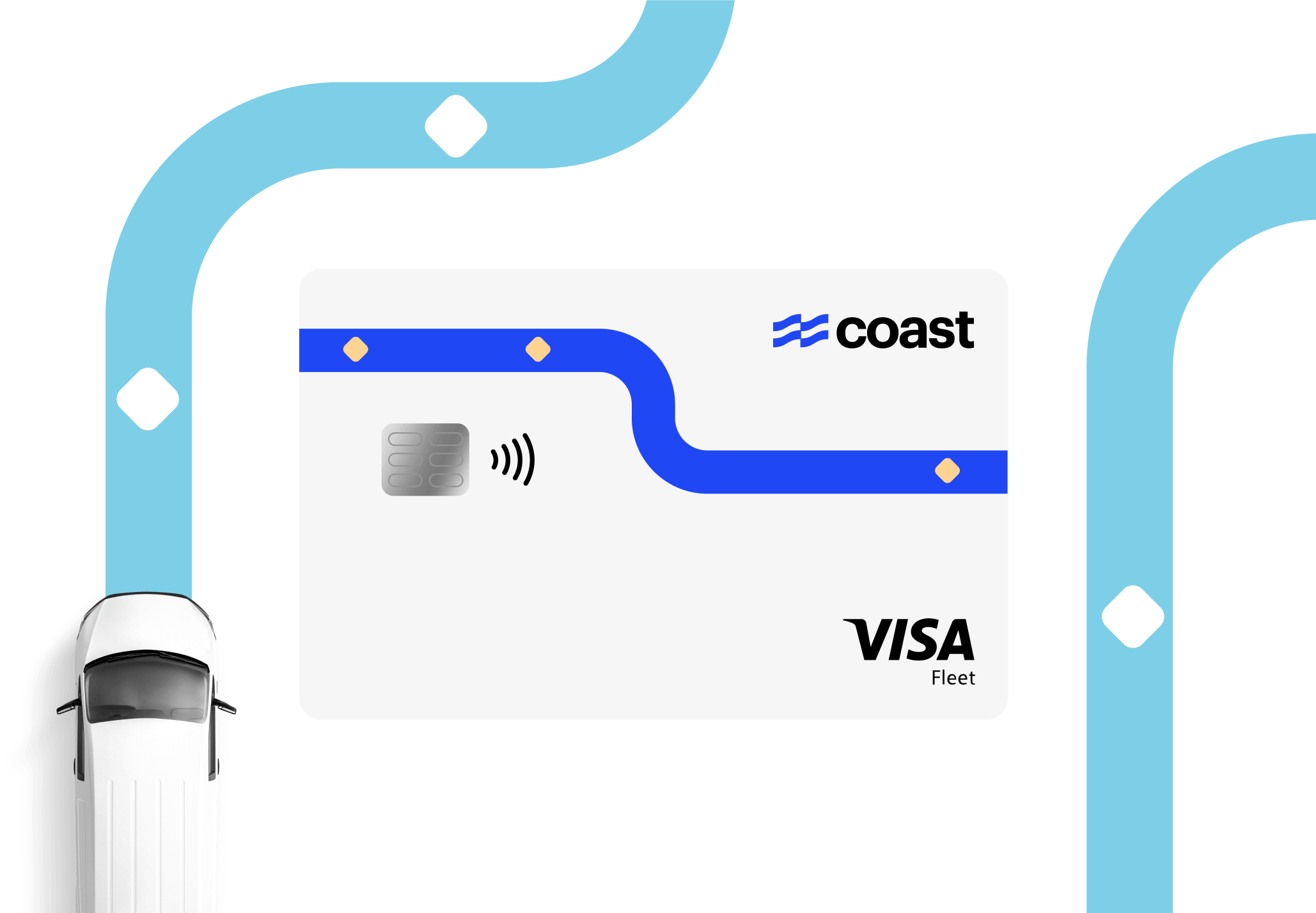The traditional view of a fleet vehicle is a semi-tractor and a 53-foot trailer. While those types of vehicles do make up a large percentage of the fleets in the United States, many other fleets consist of small and medium-sized vehicles.
In this article, we’ll discuss the answer to the question, “What is a fleet vehicle?” and offer tips for managing yours.
Table Of Contents
What Is A Fleet Vehicle?

A fleet vehicle is any motorized asset used by a company to transport people and products, conduct business, or assist with daily activity. A fleet can range from a group of service vans, rental cars, and taxicabs to a group of bulldozers, backhoes, and skid-steer loaders.
Anything with a motor that runs on gas, diesel, or aviation fuel could be part of a fleet. Similarly, a fleet can consist of any number of vehicles — two, five, 10, 25, 50, or more.
So, regardless of what kind and how many, if you own or operate vehicles as part of your day-to-day activities, you can benefit from fleet management principles and practices for controlling fuel costs, maintaining safety standards, and abiding by compliance laws.
If you’re considering purchasing a fleet vehicle or two, it’s important to be aware of the preliminary steps to consider before opening your wallet.
What To Do Before Buying A Fleet Vehicle

1) Analyze Business Needs
The type of fleet vehicle you operate depends on the type and amount of cargo you intend to transport, as well as the distance those vehicles need to cover.
Analyzing your business needs in this way will give you a general idea of the physical specifications your fleet needs to have, including:
- Type of vehicle (e.g., car, SUV, pickup truck, passenger van,
- bus, box truck, etc.)
- Size of vehicle (e.g., mid-size or full-size cargo van)
- Horsepower
- Passenger capacity
- Payload capacity
- Towing capacity
In the process, you can also identify budget constraints and other variables that will affect the purchase and use of any vehicles you’re buying.
2) Choose Between Leasing And Purchasing
Acquiring fleet vehicles typically takes two different paths: lease or purchase.
In a fleet lease, Company A (the owner of the vehicles) and Company B (your business, for example) enter into a contract whereby Company A charges Company B a certain dollar amount in exchange for the ongoing use of one or more vehicles.
The benefits of leasing your fleet include:
- Lower initial costs
- Reduced tax burden
- Lower labor costs
- Maintenance and repairs handled for you
Purchasing your fleet vehicle, on the other hand, involves paying upfront for the total cost. The benefits of purchasing your fleet include:
- No imposed limitations
- Flexibility retiring vehicles
- Pricing leverage
- Tax benefits
- Depreciation control
Analyzing the needs of your business will help you decide whether leasing or purchasing is the better option.
3) Research Fleet Management Software

Whether it’s two vehicles or 20, managing operators, routes, payloads, and other necessary variables can be extremely challenging — even for seasoned veterans.
The majority of managers, however, rely on modern fleet management software — a.k.a. vehicle telematics — to support the daily activities that come with directing any number of vehicles and their drivers.
Fleet management software helps you:
- Monitor hours of service
- Prevent driver fatigue
- Maintain Driver-Vehicle Inspections Reports (DVIRs) or electronic Driver-Vehicle Inspection Reports (eDVIRs)
- Abide by the International Fuel Tax Agreement (IFTA)
- Keep up with Compliance, Safety, and Accountability (CSA) scores
- And much more!
Before buying a fleet vehicle, research these software systems to see which one will help you streamline your activities and do your job better.
4) Apply For A Fleet Identification Number
In some cases, vehicle and equipment manufacturers will offer discounts and other amenities if you apply for a fleet identification number (FIN), fleet account number (FAN), or membership in a specific program.
Such information is used by the manufacturer to identify qualified fleet vehicle customers, process orders, track vehicle production and delivery, and for other specific customer incentives.
So, for example, let’s say that you decide to purchase several Ford Transit vans for your HVAC service and repair fleet. If you apply to receive a fleet identification number from Ford, you may be eligible for a discount (among other incentives) on the cost of your vehicles.
These programs aren’t exclusive to the big auto manufacturers. Other vehicle manufacturers — John Deere, Caterpillar, and Mack Trucks, just to name a few — offer some type of fleet program in which you can register to receive exclusive company benefits.
Tips For Managing Your Fleet

1) Track Vehicles With GPS
If you’re only dealing with a few fleet vehicles, tracking each one may not be all that complicated or time-consuming. But, if you’re dealing with five, 10, or 20 or more vehicles, tracking all of their movements can be extremely chaotic and unpredictable.
Outfitting your vehicles with GPS helps your operators navigate better and allows you to see where each vehicle is and what it’s doing at a moment’s notice. Such insight gives you more control over routes taken, activities performed, and costs accrued while on the job.
While GPS provides the most comprehensive vehicle tracking solution, other services, such as a fleet card, give managers even more insight into and control over what drivers pay for while they’re on the road.
When you harness the power of both GPS tracking and expense tracking, your business is better able to maintain its bottom line and keep everything on track and in the black.
2) Ensure The Safety Of Your Fleet
Ensuring the safety of all of your fleet assets — both vehicles and drivers alike — is a priority if you’re a fleet manager or business owner. Telematics can help.
Telematics is a broad term used to describe any number of onboard communication services and applications that work together and communicate with one another to provide real-time information on the activity, status, and performance of vehicles.
For example, once installed in a service van, telematics gives a field service manager access to such data as:
- Fuel consumption
- Engine load
- Coolant temperature
- Braking
- Acceleration
- Tire pressure
Armed with this data, you can offer drivers specific suggestions on how to operate the equipment better, create training programs for new drivers, and ensure the safety and smooth operation of all of your assets.
3) Control Fuel Costs

The price of fuel is one of the largest expenses that most fleets will contend with. Controlling those costs, then, is one of the best things you can do to reduce the fleet’s impact on your business’s bottom line.
A fleet-specific fuel card, for example, gives managers access to a whole host of data they can use to implement cost-saving solutions, increase productivity, and control what the business is spending to keep its vehicles moving.
Coupled with other fleet-management solutions, issuing a fuel card to all drivers can greatly reduce the costs of navigating the vehicle from point A to point B and back again.
4) Maintain Compliance
Fleet compliance means meeting the rules and standards that apply to all of your vehicles — be they cars, pickup trucks, vans, or some other type of motorized stock.
For most vehicles, the United States Department of Transportation (DOT) takes the lead in setting the standards with the goal of maintaining a safe, efficient transportation system that supports the U.S. economy and keeps communities connected from New York to California.
Other organizations — such as the Federal Motor Carrier Safety Administration (FMCSA) and the Commercial Vehicle Safety Alliance (CVSA) to name two — also contribute to the safety of the millions of commercial vehicles that traverse American highways every year.
They do this by implementing safety inspections and compliance checks on all fleet vehicles.
If a vehicle doesn’t reach certain standards of operation, your business can accrue serious fines, and the vehicle can be removed from service until you complete the necessary repairs or maintenance.
That’s why it’s so important to maintain the compliance of each vehicle according to the standards, laws, and regulations set forth by local, state, and federal organizations.
5) Protect Your Investment With Fleet Vehicle Insurance
One of the best ways to protect your investment while it’s on the road is with a fleet vehicle insurance policy.
Most providers that specialize in fleet insurance offer coverage for a wide variety of vehicles, including cars, vans (large and small), SUVs, pickup trucks, semis and trailers, forklifts, and heavy equipment (e.g., bulldozers, backhoes, and front-end loaders).
The convenient thing about this type of business insurance is that you don’t have to purchase a policy for each individual vehicle. You can create a plan that covers any combination of vehicles your fleet might use on a daily basis.
With a single plan like this, you can add or subtract vehicles as the need arises, but you’ll still only have one policy with which to contend.
This structure — a single policy instead of many — is much easier to manage because you only have one renewal date to keep track of.
You also benefit from cost savings. With a fleet policy, you will usually get a reduced price when compared to purchasing an individual policy for each vehicle.
And, finally, fleet insurance policies are set up in such a way so as to provide maximum flexibility when it comes to who can drive the business vehicles.
With a fleet policy, you only have to list the vehicles. But, with a personal policy, you’d have to list every single driver who might potentially operate each vehicle.
That can get very complicated very quickly with all the different vehicles your business operates, the different qualifications necessary to operate them, and the high driver turnover rate.
A fleet insurance policy keeps things as simple as possible while still providing maximum coverage for your company vehicles.
6) Incorporate Preventative Maintenance

Preventative maintenance is the theory and practice of monitoring the condition of a vehicle and making necessary repairs before an issue spreads to other systems.
Preventative maintenance is essential for the smooth operation of your fleet and many of the tips on this list wouldn’t be possible — or nearly as effective — without a maintenance program to back them up.
A robust maintenance program starts with following the original equipment manufacturer (OEM) recommended guidelines.
That said, no two vehicles will operate and wear exactly the same way — even the same make and model. The engine of one may run a bit hotter. You may need to replace the brakes of one vehicle more often. And you may have to change the oil of one vehicle after every trip.
As you get to know your fleet, you can customize the preventative maintenance plan according to the needs of each vehicle.
Doing so can help your fleet stay safe and effective for years to come.
7) Implement Pre- And Post-Trip Checklists
A big part of keeping your fleet vehicles in good repair is implementing pre- and post-trip checklists. These documents guide drivers through an inspection of the major systems on the vehicle they’re about to use.
Not only are these inspections a good idea for keeping your fleet in good and safe working order, but the pre-trip inspection checklist is also required by law.
Most inspections only take about 10 or 15 minutes and includes such information as driver ID, vehicle ID, odometer reading, and the condition, presence, and operation of:
- Seat belts
- Mirrors
- Fuel level
- Cleanliness
- Brakes
- Documentation
- Horn
- Climate control
- Body
- Lights
- Tires and wheels
- Oil level
- Windshield wipers and fluid
- Transmission fluid
- Battery
- Hoses
- Leaks
- Emergency equipment
Post-trip inspection checklists are similar, but typically include fewer items — because the systems are going to be inspected again the next time the vehicle is used — including:
- Brakes
- Windshield wipers
- Emergency equipment
- Horn
- Mirrors
- Lights
- Tires
- Wheels
The total number of steps you include on your pre- and post-trip inspection checklists can vary depending on the vehicle and its intended use. But be sure to include at least the recommended minimums so your fleet remains in compliance with federal law.
8) Follow The International Fuel Tax Agreement
The 48 contiguous United States (excluding Alaska and Hawaii) and the 10 Canadian provinces agreed to and abide by the International Fuel Tax Agreement (or IFTA for short).
The purpose of this agreement is to track where fuel taxes go as fleet vehicles pass from one state to another. Under the IFTA, fleet vehicle drivers must record:
- Fuel purchased
- Purchase locations
- Miles driven
Fleet-based businesses must then submit these details to their local IFTA office every quarter. Then, based on the number and location of miles driven, the IFTA office distributes fuel taxes to each state and province.
Most fleets rely on telematics to help with IFTA compliance, but these systems can fail. A good fleet and fuel card program is an excellent backup and provides a level of tracking and reporting that never fails.
In some cases, such programs instantly record the quantity and location of fuel fill-ups wherever the driver may be. That makes it easy to act in accordance with the International Fuel Tax Agreement.
For more information on these important maintenance procedures, take a few minutes to read these articles from the Coast blog:
- A Pre-Trip Inspection Checklist For Fleet Managers
- A Post-Trip Inspection Checklist For Fleet Managers
9) Monitor Hours Of Service

Driver fatigue is among the leading causes of accidents involving fleet vehicles on U.S. roadways.
To combat this trend, the Department of Transportation (DOT) has placed restrictions on the number of hours a single driver can operate a vehicle without a break.
Since fatigue can occur anytime, anywhere, and under any circumstances, hours of service (or HOS) is the single most important variable that fleet managers and business owners can prioritize when it comes to keeping drivers and vehicles safe on the road.
According to the Federal Motor Carrier Safety Administration (FMCSA), the most basic regulation states that:
- Property-carrying drivers may drive a maximum of 11 hours after 10 consecutive hours off duty
- Passenger-carrying drivers may drive a maximum of 10 hours after 8 consecutive hours off duty
Be sure to check the FMCSA website for more details (including such caveats as a 14-hour limit, 30-minute driving break, sleeper berth provision, adverse driving conditions, and short-haul exception).
It’s also important to verify the regulations that apply to the unique vehicles in your fleet.
In general, a fleet vehicle (or commercial motor vehicle, to be more precise) is one that 1) is used as part of a business, 2) is involved in interstate commerce, and 3) fits any of these descriptions:
- Weighs 10,001 pounds or more
- Has a gross vehicle weight rating or gross combination weight rating of 10,001 pounds or more
- Is designed or used to transport 16 or more passengers (including the driver) not for compensation
- Is designed or used to transport 9 or more passengers (including the driver) for compensation
- Is transporting hazardous materials in a quantity requiring placards
Monitoring hours of service can be a complex task, so the DOT has included provisions for electronic logging devices and telematics as well as driver training and diligence.
10) Maximize Fleet Vehicle Use
Managing your fleet well includes maximizing — or getting the most out of — the vehicles your drivers use every day.
That includes such activities as minimizing wear and tear, preventing breakdowns, optimizing routes, and one variable that many managers overlook: making sure that they’re using each vehicle to its fullest potential.
For example, your business may have 20 vehicles available for service but only operate 12 on a regular basis. The other eight vehicles sometimes go unused for days, or even weeks, while your business continues to pay the costs associated with their operation and upkeep.
Could you thin the herd, so to speak, and operate effectively on the 12 vehicles that remain?
To help you answer that question, conduct a thorough analysis of your fleet activity and find ways to reduce costs, save money, and make your business run better.
Maximizing fleet vehicle use is also about putting the right vehicles in the right situations to ensure the ongoing success of your business.
For example, if your field service team’s tools can fit easily in the backseat or the trunk of a small car, there’s no need to spend extra money purchasing, maintaining, and fueling a pickup truck — the extra space that will largely go unused.
If your technicians need a bit more cargo space and hauling capacity on occasion, would an SUV, minivan, or smaller work van be sufficient?
Or, if a work truck is essential for your team’s regular activities, would a Class 2A or 2B truck (e.g., a Ford F-150 or a Chevy Silverado 2500HD) suffice instead of a Class 4 or 5 truck (e.g., a Chevy Silverado 4500HD or a Peterbilt 325)?
Purchasing the right vehicle for the job helps maximize vehicle use, saves you money upfront, and also saves you money down the road with reduced fuel and maintenance costs.
Fleet Vehicle Management For The 21st Century

Bring your fleet vehicle management into the 21st century with the Coast fleet card. Combined with modern tracking software, Coast helps you streamline fleet compliance and management.
Our fuel card provides real-time expense tracking, line-item detail, and a powerful online management platform that puts your entire fleet in the palm of your hand and provides full visibility of every dollar spent.
For more information, visit CoastPay.com today.



